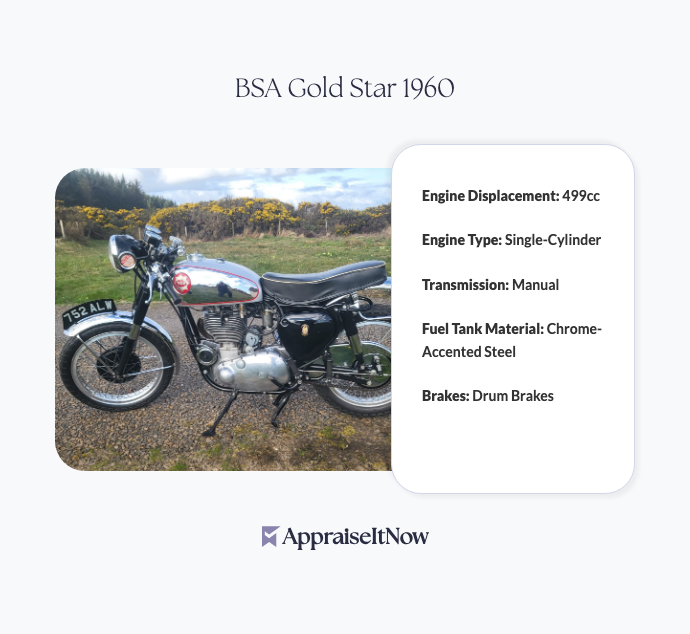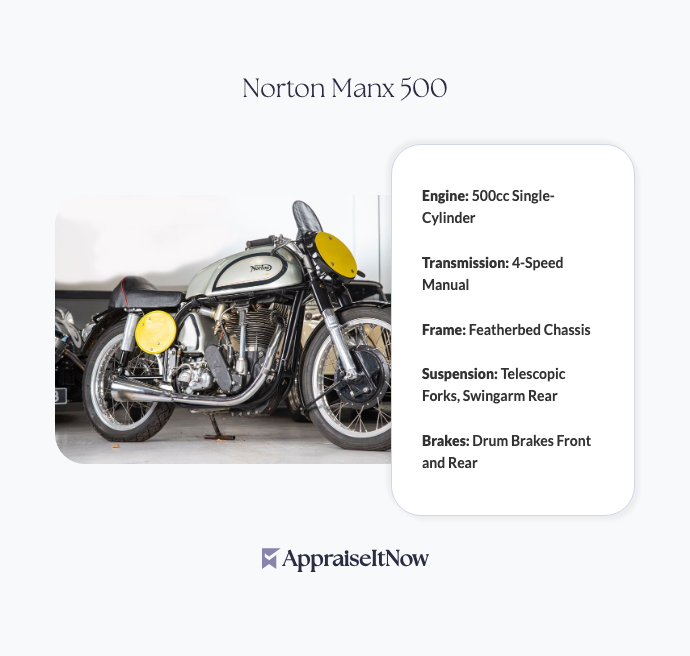<h1>How to Get Your BSA Gold Star 1960 Appraised</h1>
<p>The <strong>BSA Gold Star 1960</strong> stands as one of the most coveted vintage motorcycles in the collector's world, with current market estimates placing values between <strong>$16,000 and $20,000</strong> for quality examples. If you own this legendary British machine or are considering acquiring one, understanding the appraisal process ensures you get an accurate valuation whether you're buying, selling, or insuring your investment.</p>
<h2>Understanding BSA Gold Star 1960 Market Value</h2>
<p>Your BSA Gold Star 1960 represents far more than just transportation—it's a piece of British motorcycle engineering history. Produced by <strong>Birmingham Small Arms Company (BSA)</strong>, fewer than 500 units rolled off the production line in 1960, making scarcity a fundamental value driver. The original Gold Star design, introduced in 1938, became legendary for its exceptional performance and elegant styling, but the 1960 model particularly captures collector attention due to its refined features and proven reliability.</p>
<p>The 499cc single-cylinder engine produces impressive power for its era, achieving top speeds exceeding 100 mph—remarkable engineering that justified the Gold Star's racing pedigree. The model won numerous racing championships throughout its production run, establishing itself as a symbol of the golden age of British motorcycle manufacturing. This combination of historical significance, rarity, and documented performance creates the valuation foundation you'll see reflected in professional appraisals.</p>
<blockquote>
<p><strong>Pro Tip</strong>: BSA Gold Stars with documented racing history or competition success can command 15-25% premiums over standard models, similar to how <a href="/types/automobile">automobile appraisals</a> value racing provenance.</p>
</blockquote>
<h2>Key Factors That Influence Your Gold Star's Value</h2>
<p>When seeking a professional appraisal, understanding what appraisers examine helps you prepare documentation and appreciate the final valuation. Several interconnected factors determine where your specific 1960 model falls within the $16,000-$20,000 range.</p>
<p><strong>Originality and restoration status</strong> represents perhaps the most significant value driver. An unrestored, original-condition Gold Star with matching numbers on engine and frame components commands premium pricing. Conversely, while high-quality restorations maintain substantial value, they typically appraise lower than original examples because collectors prize authenticity. The condition of original paint, chrome accents, and mechanical components directly impacts valuation, as does the presence of the iconic fuel tank badging that defines the Gold Star's visual identity.</p>
<p><strong>Documentation and provenance</strong> significantly influence appraisal outcomes. Ownership history, maintenance records, and any competition documentation add credibility to your valuation. Unlike purchasing a used <a href="/types/motorcycle">motorcycle</a> blindly, a well-documented Gold Star provides confidence in its authenticity and history. Service records demonstrating regular maintenance, original purchase documentation, or competition entry forms all enhance market appeal and justify higher valuations.</p>
<p><strong>Engine and mechanical condition</strong> matter enormously. The 499cc powerplant's mechanical soundness—including bore condition, compression figures, and oil circulation integrity—directly affects value. Appraisers conduct compression tests, inspect for internal corrosion, and verify that all original components remain intact. A Gold Star that starts reliably and runs smoothly commands substantial premiums over one requiring mechanical restoration.</p>
<blockquote>
<p><strong>Appraisal Consideration</strong>: Professional appraisers inspect the frame for previous accident damage, crack repairs, or modifications that might indicate past restoration work affecting original value.</p>
</blockquote>
<h2>Documentation Requirements for Accurate Appraisal</h2>
<p>Preparing comprehensive documentation streamlines your appraisal process and supports accurate valuation. Think of documentation similarly to how <a href="/types/personal-property">personal property</a> appraisals require supporting evidence—photographs and records tell your Gold Star's story to the appraiser.</p>
<p>Begin by gathering high-resolution photographs from multiple angles: overall shots showing the motorcycle's stance, close-ups of the serial numbers (frame, engine, and any other stamped locations), detail shots of the iconic fuel tank badging, interior of the fuel tank, condition of chrome and paint, engine close-ups, and any visible wear patterns or patina. These images help appraisers assess condition even during preliminary consultations and provide reference material for their written reports.</p>
<p>Compile any existing documentation including the original title or registration (if available), purchase receipts, service invoices, or maintenance logs demonstrating care history. If the motorcycle appears in any magazine features, competition records, or period advertising, include copies. Appraisers use this contextual information to establish authenticity and estimate manufacture timing with precision.</p>
<p>Factory specifications for your model year matter tremendously. Document original specifications like seat type, handlebar style, fork design, and any optional equipment that came factory-installed versus added later. This level of detail distinguishes original 1960 models from later reproductions or bikes modified over decades of ownership, directly impacting valuation accuracy.</p>
<h2>Professional Appraisal Credentials and Expertise</h2>
<p>When selecting an appraiser for your BSA Gold Star 1960, credentials matter significantly. Look for appraisers holding certifications from recognized organizations including the <strong>American Society of Appraisers (ASA)</strong>, <strong>International Society of Appraisers (ISA)</strong>, <strong>Appraisers Association of America (AAA)</strong>, or similar recognized credentials. These designations require extensive training in valuation methodology and adherence to <strong>USPAP (Uniform Standards of Professional Appraisal Practice)</strong>, ensuring your appraisal meets professional standards accepted by insurance companies, courts, and financial institutions.</p>
<p>Specialized motorcycle appraisal expertise trumps general vehicle knowledge. An appraiser familiar specifically with British motorcycle history, BSA manufacturing specifications, and Gold Star variations provides substantially more accurate valuations than generalists. They understand production changes between model years, recognize original versus reproduction components, and know market dynamics affecting classic motorcycle values.</p>
<p>AppraiseItNow connects you with credentialed appraisers experienced in <a href="/types/memorabilia-and-collectibles">memorabilia and collectibles</a> valuation, including vintage motorcycles. Our network includes specialists who understand BSA history, can verify authenticity, and provide detailed documentation suitable for insurance, sale, or estate purposes.</p>
<blockquote>
<p><strong>Selection Tip</strong>: Ask potential appraisers about their specific experience with BSA Gold Stars and British motorcycles generally. Their familiarity with this marque directly affects valuation accuracy.</p>
</blockquote>
<h2>How Appraisal Reports Support Your Needs</h2>
<p>Professional appraisal reports serve multiple purposes beyond satisfying curiosity about your motorcycle's worth. For <strong>insurance purposes</strong>, a certified appraisal establishes replacement value that your insurer uses to determine coverage limits and premiums. Classic motorcycle insurance typically requires professional appraisals to justify coverage levels, particularly for valuable examples like your Gold Star.</p>
<p>When <strong>planning to sell</strong>, a professional appraisal provides data supporting your asking price. Rather than guessing at market value, you present potential buyers with a credible, third-party valuation backed by documented methodology. This confidence-building document streamlines negotiations and protects both parties.</p>
<p>For <strong>estate planning</strong>, appraisals establish fair market value used in will distributions, tax calculations, and probate proceedings. Family disputes over motorcycle value often resolve through professional appraisals that provide objective, defensible valuations. Similarly, if your Gold Star factors into <a href="/types/business-assets">business assets</a> for corporate valuations or loan collateral assessments, appraisal documentation becomes essential.</p>
<p>The appraisal report itself includes detailed condition descriptions, photographs, comparable sales analysis, market research, specifications verification, and the appraiser's professional opinion of value. This comprehensive documentation protects your interests across numerous scenarios and provides historical reference as your motorcycle's value evolves over time.</p>
<h2>Market Demand and Rarity Factors</h2>
<p>The BSA Gold Star 1960 occupies a unique market position where supply scarcity meets sustained collector demand. With fewer than 500 units produced that year, finding a well-preserved example represents a genuine rarity. This limited supply, combined with enthusiast demand from riders and collectors who appreciate British motorcycle heritage, creates stable-to-appreciating values.</p>
<p>Your Gold Star exists in a different market segment than mass-produced motorcycles. While common bikes depreciate like automobiles, collectible classics like the Gold Star appreciate as their surviving numbers diminish and nostalgia deepens. The legendary status the Gold Star earned through racing championships and continued recognition in classic motorcycle publications maintains collector interest across generations.</p>
<p>International demand also supports Gold Star values. British motorcycle enthusiasts worldwide actively seek original examples, particularly models with documented competition history or unique specifications. This global collector base provides market depth that sustains pricing even during economic downturns affecting other collectible categories. Understanding these factors parallels how <a href="/types/sports-memorabilia">sports memorabilia</a> valuations account for collector passion and rarity.</p>
<blockquote>
<p><strong>Market Insight</strong>: The BSA Gold Star's appearance in classic motorcycle films and its featured status in restoration documentation continually introduces new collectors to the marque, supporting long-term value stability.</p>
</blockquote>
<h2>Valuation Methods Used in Professional Appraisals</h2>
<p>Professional appraisers employ established valuation methodologies to arrive at your Gold Star's specific value within the $16,000-$20,000 range. The <strong>comparative sales approach</strong> analyzes recent sales of similar 1960 Gold Stars, adjusting for condition differences, mileage, documentation quality, and rarity factors. Appraisers track auction results, private sales documented in collector communities, and dealer inventory to identify market trends.</p>
<p>The <strong>cost approach</strong> calculates what restoring your motorcycle to original condition would require, then subtracts typical restoration costs from the completed value. This method provides particularly useful benchmarking for partially restored examples or bikes requiring specific remedial work.</p>
<p>The <strong>income approach</strong>, while less common for personal motorcycles, applies when bikes generate revenue through museum display, competition, or rental arrangements. Documentation of such income streams supports higher valuations.</p>
<p>Most professional appraisals weight the comparative sales approach most heavily because it directly reflects actual market transaction data. Your appraiser synthesizes all available information—condition assessment, market research, comparable sales, and technical specifications—into a defensible valuation supported by documented methodology.</p>
<h2>Understanding Current Market Conditions</h2>
<p>Today's classic motorcycle market reflects strong collector interest in British machines generally and Gold Stars specifically. Younger collectors discovering vintage bikes through digital media platforms fuel demand, while established enthusiasts maintain passion for these historically significant motorcycles. This bifurcated collector base—nostalgic longtime enthusiasts plus newly engaged younger collectors—creates resilient market conditions.</p>
<p>Cryptocurrency wealth and pandemic-era discretionary spending have elevated collector asset values broadly, with motorcycles sharing in this appreciation. However, Gold Star values remain grounded in fundamental scarcity and desirability rather than speculative excess, suggesting value stability beyond current market cycles.</p>
<p>Storage availability and riding accessibility also influence values. Many collectors appreciate Gold Stars as rideable classics rather than museum pieces, supporting premium pricing for mechanically sound, well-maintained examples. This practical appeal distinguishes Gold Stars from purely decorative collectibles, contributing to sustained collector commitment.</p>
<h2>Preparing Your Motorcycle for Appraisal</h2>
<p>Before scheduling your appraisal appointment, basic preparation ensures the appraiser can thoroughly assess your Gold Star. Clean the motorcycle to reveal original finish condition and surface details, but avoid aggressive polishing or restoration attempts immediately before appraisal. Professional appraisers prefer seeing authentic condition including patina because it guides their assessment of originality.</p>
<p>Gather all documentation mentioned earlier—photographs, service records, original paperwork, registration history, and any competition documentation. Organize this material chronologically so the appraiser can quickly review your bike's history.</p>
<p>If your Gold Star has mechanical issues, disclose these upfront. Appraisers appreciate transparency and adjust valuations accordingly. Attempting to hide problems only leads to appraisal shock when professionals discover undisclosed condition issues during inspection.</p>
<p>Ensure safe access to the motorcycle. If it's in running condition, demonstrate starting and basic operation, but let the appraiser handle detailed mechanical inspection. If the bike's stored or non-running, simply allow full physical access for comprehensive examination.</p>
<blockquote>
<p><strong>Pre-Appraisal Tip</strong>: Locate the VIN/frame number and engine serial number before the appraiser arrives. Having these readily available streamlines the valuation process and verification procedures.</p>
</blockquote>
<h2>Summary: Protecting Your BSA Gold Star Investment</h2>
<p>Your <strong>BSA Gold Star 1960</strong>, valued between $16,000 and $20,000, represents a significant collectible asset deserving professional appraisal services. Whether acquiring this legendary British machine, planning estate distribution, establishing insurance coverage, or preparing for sale, a certified appraisal provides the documentation and expertise ensuring accurate valuation.</p>
<p>The appraisal process itself proves straightforward when you understand what appraisers examine and prepare appropriate documentation. Professional expertise in British motorcycle history, combined with established valuation methodologies, transforms subjective value estimates into defensible, documented assessments supporting your financial and legal interests.</p>
<p>Appraisers from <strong>AppraiseItNow</strong> bring specialized knowledge of vintage motorcycles and USPAP compliance to every engagement, ensuring your Gold Star receives thorough, accurate evaluation. Professional appraisals aren't luxuries for casual inquiry—they're essential documentation protecting your investment and providing confidence in ownership decisions.</p>
<blockquote>
<p><strong>Key Takeaway</strong>: A certified appraisal of your BSA Gold Star 1960 provides essential documentation for insurance, sale, or estate purposes, ensuring you understand both the historical significance and accurate monetary value of this iconic British motorcycle.</p>
</blockquote>







.avif)







